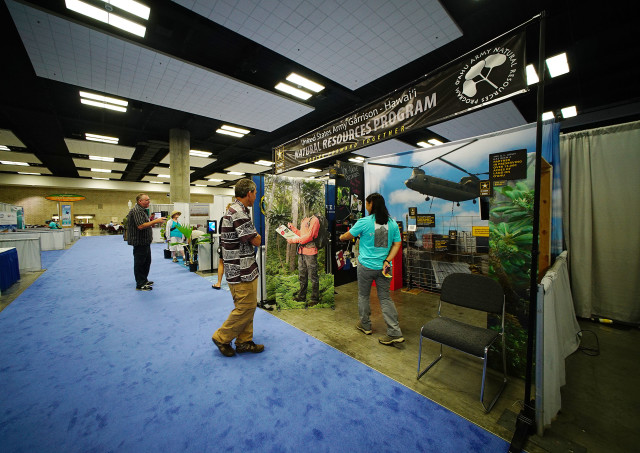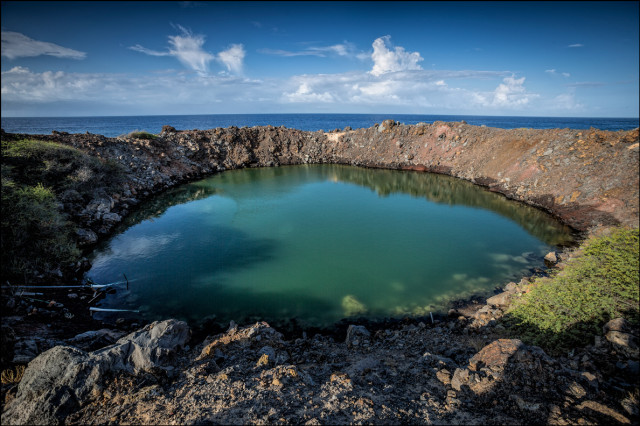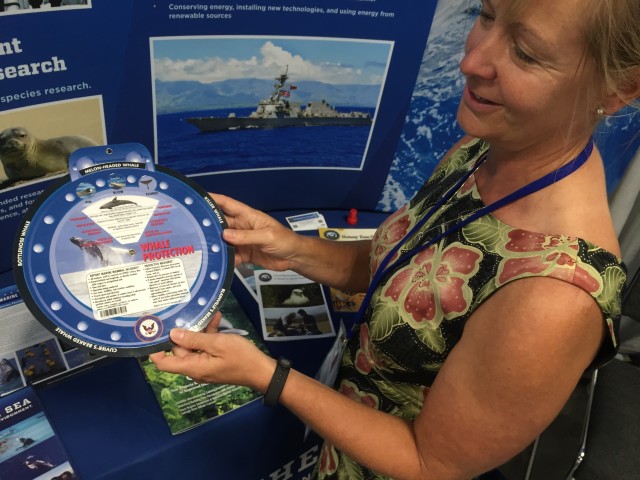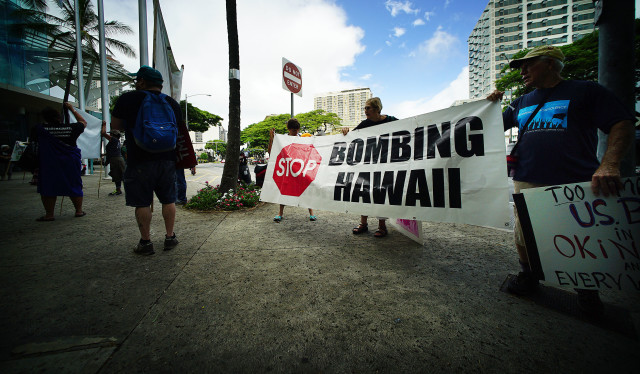The Military Tries to Sell Itself as Positive Environmental Force
ENVIRONMENT, 19 Sep 2016
Chad Blair | Civil Beat – TRANSCEND Media Service
The U.S. Army, Navy and Marines made a pitch to conservationists from around the world that they share the same goals. Not everyone is buying it.
15 Sep 2016 – To some conservationists, the U.S. military is one of the most destructive forces on the planet.
In Hawaii alone, environmental groups have battled the military over armored vehicles that tore up the land and sonar that caused injury and death to marine wildlife.
Perhaps the largest example of the military’s impact on Hawaii is the unpopulated island of Kahoolawe, which was used for target practice for decades. Despite a multimillion-dollar cleanup of unexploded ordnance, the island and its surrounding waters are still littered with bullets, shells and bombs.
But none of that would have been evident if you happened upon any of three exhibits set up by the military at the World Conservation Congress, the massive gathering of conservationists that took place earlier this month in Honolulu.
The Navy, Army and Marines used the 10-day mega conference to pitch themselves as outstanding stewards of the land and sea and boast about the money they’ve spent to protect the environment — a contrast with their legacy of environmental damage.

The U.S. Army Natural Resources Program Hawaii’s display booth at the World Conservation Congress at the Hawaii Convention Center.
Cory Lum/Civil Beat
Taylor Marsh works with the Army Natural Resource Program Hawaii, which is run by civilians and based at Schofield Barracks. At the Army’s exhibition booth, Marsh said the branch spends $7 million a year to mitigate damage to local ecosystems. He described the program as the “most well-funded conservation organization on Oahu.”
“We are actually restoring and protecting more than any other program,” he said, pointing out he works with more than 60 staff members and four field teams. “As far as endangered species are going, we are having really good success.”
Some activists and environmentalists are unswayed by the military’s efforts, though. Outside the conference one day, dozens of protesters chanted slogans like, “Occupation is not conservation!”
“The track record in Hawaii is not good,” said David Henkin, a staff attorney at the Honolulu office of Earthjustice.
Henkin would know.

Sailor’s Hat on Kahoolawe, where the Navy dropped a 500-pound TNT bomb to simulate the effects of an atomic blast.
PF Bentley/Civil Beat
A History Of Destruction
Earthjustice has led the legal fight against Army Stryker brigades, which tore up plants and soil around Schofield Barracks on Oahu as well as at Parker Ranch and the Pohakuloa training areas on the Big Island. The Strykers, heavily armored vehicles, destroyed a centuries old heiau (Hawaiian temple).
Henkin’s work has also involved suing the Navy over its use of sonar off the western shore of Kauai. The Navy, he said, brags that it protects whales, but evidence has shown some whales washing up dead, their brains fried and their eardrums bleeding.
“We get out and try and save what is precious to Oahu.” — Taylor Marsh of the U.S. Army
The military’s history when it comes to the environment, Henkin said, is an ugly one.
It has included turning Pearl Harbor, which he described as “once a vibrant ecosystem with pearls,” into “a toxic bog.”
The military has also held live-fire training in the verdant and sacred Makua Valley on Oahu’s Leeward Coast.
“There are over 100 sites in Makua eligible for listing on the National Historic Register, some bearing the scars of arms and bullets,” Henkin said.
How The Military Helps The Environment
At the conference, which was put on by the International Union for Conservation of Nature and plays a big role in setting worldwide environmental policy, the military had posters and brochures at its booths highlighting some of the ways it says it’s doing what it can to help preserve and protect Hawaii’s environment.

A representative of the Navy demonstrates a “whale wheel” to identify different types of the marine mammals.
Chad Blair/Civil Beat
The Navy pointed to its modified lighting at installations on Kauai to reduce impacts to birds like the Newell’s shearwater and Hawaiian petrel. The Army noted its planting of more than 27,000 endangered plants on Oahu and the Big Island. The Air Force talked about its restoration of the Puewai wetlands at Bellows Air Force Station in Windward Oahu.
“All the services are working toward providing more awareness and more outreach to the communities, to get them involved in the mitigation in some of the environmental programs we have going on here,” said Jomia Blas, who worked the Air Force’s booth.
Speaking specifically about the Air Force, Blas said the branch “is very adamant about protecting and preserving the land that we manage and that we are currently residing on.”
“We take our environmental programs very seriously,” Blas said, “not only for the mission for us to execute the things that we need to do in using Hawaii as a strategic hub, but also for giving back to the environment for sustainability reasons.”
Only Following The Law
But Henkin said that, if the military is doing anything to mitigate damage to Hawaii, it’s only because it required to do so by law.
Those laws are the National Environmental Policy Act, the Marine Mammal Protection Act and the Endangered Species Act. The military works in coordination with the U.S. Fish and Wildlife Service and the National Oceanic and Atmospheric Administration.
“That is the only reason they actually do it,” Henkin said. “They want to portray their efforts as ‘good neighbor’ and out of goodness of heart, but they are doing it because they have to. I appreciate when they sometimes follow the law, but I also appreciate that, when they don’t, we can take them to court and sue them.”

Demonstrators outside the World Conservation Congress on Sept. 3 hold signs protesting the military.
Cory Lum/Civil Beat
Henkin added: “It is not a favor they are doing for the people of Hawaii, some sort of act of generosity on their behalf. They are spending our money, taxpayer money.”
‘We Are Environmentalists’
Marsh, who worked the Army’s booth, acknowledged that the those who say the military can be destructive to land and sea life have “a valid point.” He mentioned several of the same degraded sites in the islands as Henkin did.
But there is a bigger picture to be seen, he said.
“We are environmentalists and a lot of us are local,” said Marsh. “We get out and try and save what is precious to Oahu, because the Army has so many training areas and owns so much land on Oahu and a lot of the land is precious endemic native forest.”
___________________________________
Chad Blair is a reporter for Civil Beat. You can reach him by email at cblair@civilbeat.org
Go to Original – civilbeat.org
DISCLAIMER: The statements, views and opinions expressed in pieces republished here are solely those of the authors and do not necessarily represent those of TMS. In accordance with title 17 U.S.C. section 107, this material is distributed without profit to those who have expressed a prior interest in receiving the included information for research and educational purposes. TMS has no affiliation whatsoever with the originator of this article nor is TMS endorsed or sponsored by the originator. “GO TO ORIGINAL” links are provided as a convenience to our readers and allow for verification of authenticity. However, as originating pages are often updated by their originating host sites, the versions posted may not match the versions our readers view when clicking the “GO TO ORIGINAL” links. This site contains copyrighted material the use of which has not always been specifically authorized by the copyright owner. We are making such material available in our efforts to advance understanding of environmental, political, human rights, economic, democracy, scientific, and social justice issues, etc. We believe this constitutes a ‘fair use’ of any such copyrighted material as provided for in section 107 of the US Copyright Law. In accordance with Title 17 U.S.C. Section 107, the material on this site is distributed without profit to those who have expressed a prior interest in receiving the included information for research and educational purposes. For more information go to: http://www.law.cornell.edu/uscode/17/107.shtml. If you wish to use copyrighted material from this site for purposes of your own that go beyond ‘fair use’, you must obtain permission from the copyright owner.